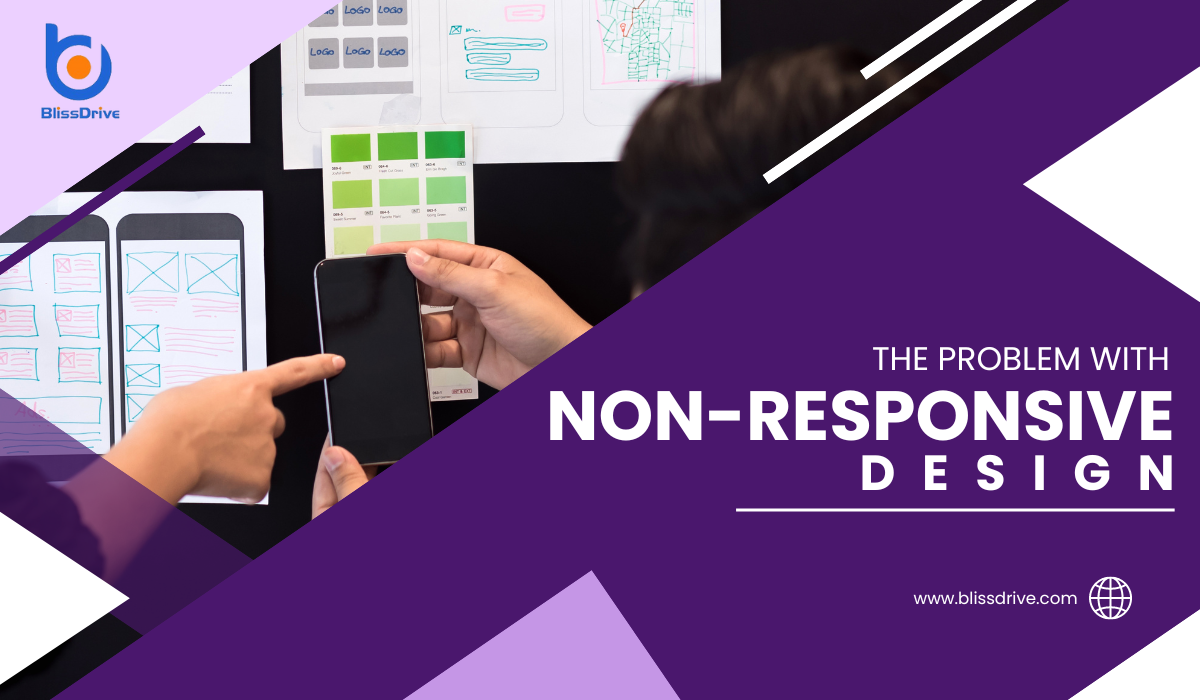Digital Marketing Services
Learn More About Us

In today's digital world, a mobile-responsive website is crucial. Many businesses still use outdated, non-responsive designs that don't fit today's variety of screen sizes. However, this mistake can drive visitors away and cause:
In this guide, let's discuss the problems in detail and help make your website mobile-friendly.
A non-responsive website does not adapt to different screen sizes and devices. Unlike responsive websites, non-responsive sites have a static layout intended for only one screen size.
This often results in a poor user experience when viewed on mobile phones, tablets, or other devices that do not match the original design specifications.
Key characteristics of non-responsive design include:
Users struggle with navigation menus and links that are not optimized for touchscreens. This makes it hard to explore the website on a mobile device.
Text and images may not adjust to fit different screen sizes, causing them to appear too small or too large. Users often need to zoom in and out to read or view them properly.
Non-responsive websites have poor loading speed. Slow loading discourages users from waiting, leading them to leave the site prematurely.
Elements like buttons or forms may not work well on a touchscreen. This would frustrate the users trying to submit information or navigate through the site.
The cumulative effect of these issues leads to a negative user experience. This increases the likelihood of users leaving the site and not returning.
Non-responsive design can impact search engine rankingsThe position at which a website appears in the SERP.. Search engines like Google prefer mobile-friendly websites in their results. They aim to deliver the best user experience to internet users. This is why they rank sites that are fast, accessible, and easy to use on mobile devices.
If your website is not optimized, search engine algorithms will rank it lower. This will reduce its visibility and can leadA potential customer referred by an affiliate who has shown interest in the product or service but h... to decreased traffic.
Non-responsive design can lead to considerable revenue losses. Users abandon sites that are difficult to navigate and interact with on a mobile device.
This impacts conversations as businesses lose sales when users leave without engaging further.
The impact on brand reputation and customer retentionStrategies aimed at keeping existing customers engaged and encouraging repeat purchases. is significant. A non-responsive website suggests a business does not value user experience.
This can harm a brand's image. It makes them appear outdated or disconnected from current technology and customer needs. Over time, this perception can weaken customer loyaltyThe likelihood of customers to continue purchasing from a brand over time. and discourage new customers from engaging with the brand. This affects long-term revenue and growth opportunities.

Start by using tools like Google’s Mobile-Friendly TestA tool that evaluates how well a website performs on mobile devices. to check how well your website performs on various devices.
This initial assessment will highlight areas that need improvement.
Install a responsive framework such as Bootstrap or Foundation. These frameworks provide a grid system and components that automatically adjust to the device's screen size.
This will ensure that your website is accessible and functional across all devices.
Approach your website’s redesign with a mobile-first philosophy. Design for smaller screens first, then scale up for desktops.
This ensures that mobile users experience functionality and aesthetics that are on par with desktop users.
Optimize images and media files for fast loading.
Use responsive image techniques like the srcset attribute. This would allow the browser to choose the most appropriate image size based on the device's screen.
Simplify your website’s navigation and interface to improve usability on mobile devices. Consider implementing a hamburger menu for mobile users to maximize space and maintain clarity.
Enhance touch interactions by making buttons, links, and other interactive elements large enough to be easily tapped. This avoids user frustration and enhances the user experience.
Test and Feedback
Test your new responsive designA web design approach that makes web pages render well on a variety of devices and window or screen ... across multiple devices and browsers to ensure consistency and functionality. Gather feedback from users to identify areas for further improvement.
Keep your website’s design and content updated and optimized based on emerging trends and technologies. Regular updates will keep your website competitive and responsive to user needs.
In conclusion, responsive web design is crucial. It ensures an optimal user experience, boosts your SEO, and secures your business's future. Act now to ensure your website meets the needs of today's mobile-centric consumers.
Ready to upgrade your website? Contact Bliss Drive today for expert web design services that ensure your site thrives in a mobile-first world.
